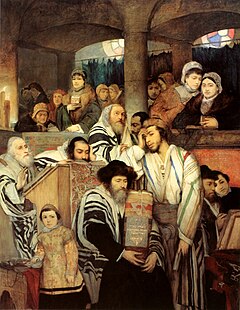
Back Jom Kippoer Afrikaans Jom Kippur ALS Godbōtdæg ANG يوم الغفران Arabic يوم الغفران ARZ Yom Kippur AST Yom-Küpür Azerbaijani Ём-Кіпур Byelorussian Йом Кипур Bulgarian Yom Kippour Breton
| Yom Kippur יוֹם כִּפּוּר | |
|---|---|
 | |
| Observed by | Jews and Samaritans |
| Type | Jewish, national (in Israel) |
| Significance | Atonement and repentance to God for personal sins; sealing of one's fate for the upcoming year |
| Observances | |
| Date | 10 Tishrei |
| 2024 date | Sunset, 11 October – nightfall, 12 October |
| 2025 date | Sunset, 1 October – nightfall, 2 October |
| 2026 date | Sunset, 20 September – nightfall, 21 September |
| 2027 date | Sunset, 10 October – nightfall, 11 October |
| Frequency | Annual (Hebrew calendar) |
| Related to | Rosh Hashanah |
| Part of a series on |
| Judaism |
|---|
   |
Yom Kippur (/ˌjɒm kɪˈpʊər, ˌjɔːm ˈkɪpər, ˌjoʊm-/ ⓘ YOM kip-OOR, YAWM KIP-ər, YOHM-;[1] Hebrew: יוֹם כִּפּוּר Yōm Kippūr [ˈjom kiˈpuʁ], lit. 'Day of Atonement') is the holiest day of the year in Judaism.[2][3][4] It occurs annually on the 10th of Tishrei,[5] corresponding to a date in late September or early October.
For traditional Jewish people, it is primarily centered on atonement and repentance. The day's main observances consist of full fasting and asceticism, both accompanied by extended prayer services (usually at synagogue) and sin confessions. Many Jewish denominations, such as Reconstructionist Judaism (vs. Reform, Conservative, Orthodox, etc.), focus less on sins and more on one's goals and accomplishments and setting yearly intentions.
Alongside the related holiday of Rosh Hashanah, Yom Kippur is one of the two components of the High Holy Days of Judaism. It is also the last of the Ten Days of Repentance.
- ^ Wells, John C. (2008). Longman Pronunciation Dictionary (3rd ed.). Longman. ISBN 978-1-4058-8118-0.
- ^ "Festival 2016: Seven Festivals Celebrated in the Israelite Samaritan Year". Israelite Samaritan Information Institute. 24 July 2018. Archived from the original on 1 September 2019. Retrieved 13 September 2022.
- ^ "The Festival of Yom Kippur (The day of Atonement)". The Samaritans. Archived from the original on 13 September 2022. Retrieved 13 September 2022.
- ^ "Afflicting the Soul: A Day When Even children Must Fast – TheTorah.com". thetorah.com. Archived from the original on 13 September 2022. Retrieved 13 September 2022.
- ^ Numbers 29:7